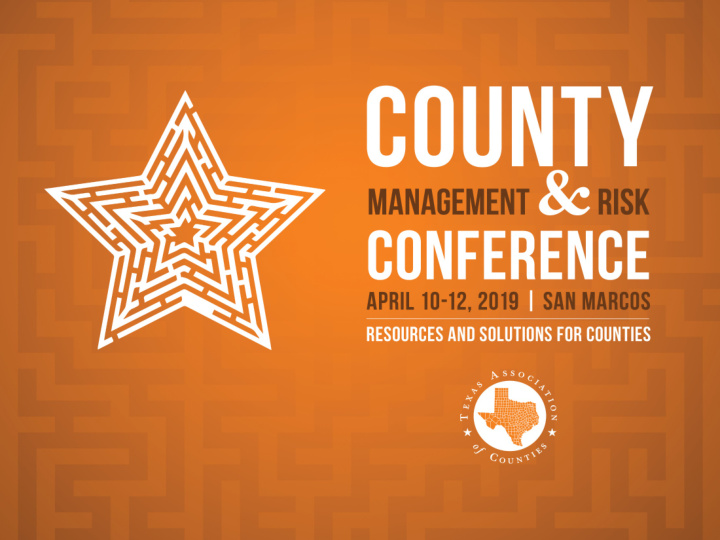



Looking Forward: T The Changing ng Climate of Workers’ ’ Compensation Presented by: Stacy Corluccio, TAC RMS Claims Manager
Yesterday in Workers’ ’ Compensati tion
Today a and Tomorr rrow in Work rkers’ Compen ensation on
Tod oday’s Sess Sessio ion Con Content • Post-Traumatic Stress Disorder (PTSD) • Presumption (Cancer) • Medical Marijuana • Psycho-Social Barriers and RTW • Technology in Workers’ Compensation
1 Event 55% 7-8% PTSD *U.S. Department of Veterans Affairs, Property Casualty 360, Post-Traumatic Stress Disorder in Workers’ Compensation, June 25,2018
Firefighters 7-37% Law EMTs > 20% Enforcement 19% PTSD How many do not report and why? *The National Center for Biotechnical Information *McCanlies, Mnatsakanova, Andrew, Burchfiel, & Violanti, 2014
PTS TSD in Te Texas First Responders in Texas Labor Code §504.019 Peace Officer Emergency Medical Emergency Medical (Article 2.12 Code Technician, Care Attendant of Criminal Intermediate and Procedure) Paramedic Firefighter (subject Licensed Paramedic to certification by TCFP)
What is P PTS TSD? The National Institute of Mental Health “a disorder that develops in some people who have experienced a shocking, scary, or dangerous event.”
PTS PTSD C Claims • Anyone witnessing violence or a horrific accident while at work (course and scope) • Anyone badly injured at work • Anyone with prolonged pain or suffering due to a work-related injury or treatment
How Mental I Injuri ries M Manifest Mental- Physical- Physical Mental Mental- Mental Wait… What?
Diagnosing PTS PTSD “Trauma- and Stress-Related Disorders”
Compensabl ble P PTSD i D in Texas Preponderance Based on of Evidence Event in Course Diagnosis from Indicates Event and Scope of APA – DSM-5 was Substantial Employment Contributing Factor
Changing the Culture I am sorry, you cannot return to work with PTSD
Considerations for r the County • More training for first responders on how to recognize PTSD • Early counseling and intervention – Don’t wait for time to pass after the event • How can TCOLE assist? • How can the county accommodate the employee with PTSD and RTW?
Cancer r Presumption i in Firefighters and EM EMTs
Presumption L n Law aw • Government Code §607.051 and §607.055 • Regularly responded to fires, or • Exposed during an event involving the documented release of radiation or a known or suspected carcinogen, and • Cancer is known to be associated with fire fighting or exposure to heat, smoke, radiation, or a known or suspected carcinogen as determined by the International Agency on Research on Cancer
Criteri ria f for P r Presumption Participates in a minimum of 40% of drills conducted by the individual's department AND 25% of the fire or other emergency calls received by the department during the time that the volunteer firefighter is on call
More e Pres esumption on Requirem emen ents • Employed 5 or more years in the role • Physical examination failed to reveal evidence of cancer • Tobacco exclusions for users and spouses who use • May be rebutted • Preponderance of the evidence • Risk factor, accident, hazard, or other cause not associated with the individual's service as a firefighter or emergency medical technician caused the individual's disease or illness.
Marijuana i in Work rkers’ Compen ensation on
Texas - 1 of 13 States Low THC (.5%), High CBD (10%) Medical Situations Limited Circumstances
Medical M Marijuana in T Texas • Legislative measure filed would expand the list of debilitating medical conditions (epilepsy) that qualify for medical cannabis under the 2015 Compassionate Use Act • Terminal cancer • Autism • Crohn's disease • PTSD
Impact on Em Employers and W Work rkers’ Compen ensation on Coming back to Cost vs. Benefit Length of work? Treatment Productivity issues Drug Free Business Needs More Injuries? workplace
Psychosocial Barriers and Return rn to W o Wor ork No. 1 Barrier to Successful Outcomes Business Insurance, March 30, 2017 - Rising Medical Solutions’ 2016 Workers’ Compensation Benchmarking Study survey of 492 claims professionals
Job Satisfaction Beliefs about Psychosocial Cause of Support at Injury and Home Barriers Pain Work Relationships
What C Can Em Employers d do? 1. Build and maintain positive relationships with employees 2. Be flexible to motivate employees 3. Explain your return-to-work policy 4. Employee Assistance Plan not a stigma Direct, Positive Impact on Recovery and Outcome!
Technology T Today • Risk and Insurance “Three Powerful Technologies Are Joining Forces to Revolutionize Workplace Safety” • Antony Ireland | February 21, 2019 • “Virtual workers” review the physiological limits of a task before sending a live human to do it” • Today virtual technology is a training tool
Technology Acronym yms and and Applicati tion • Sensor-laden wearable technology (wearables), virtual reality (VR) and augmented reality (AR)
Technology T Today VR and AR together How can or will this work in counties?
Wake Up!
Sleep epy D Driver ers? • Ford’s SafeCap monitors truck drivers’ brainwaves to detect tiredness, instructing them to pull over and communicate with headquarters. • Can this be applied to counties? • Hurdles?
Challenges wi with Techn hnology • Building a large and reliable dataset to model workers and work environments • Data processing power • Cost – now? Several years from now?
More C e Challen enges es • Wearables generate enough data without the demands of VR or AR on a single server • Issues around the consent of workers and the privacy and security of data generated by wearables • Challenges surmountable?
Looking Forward • Early intervention – PTSD • Understanding risks of your Volunteer Firefighters and EMTs • How would medical marijuana affect county business? • Technology – how can it be leveraged to reduce claims in the county?
Thank Y You u for A Attendi ding Questions? Contact StacyC@county.org (512) 478-8753, ext. 3634.
Recommend
More recommend